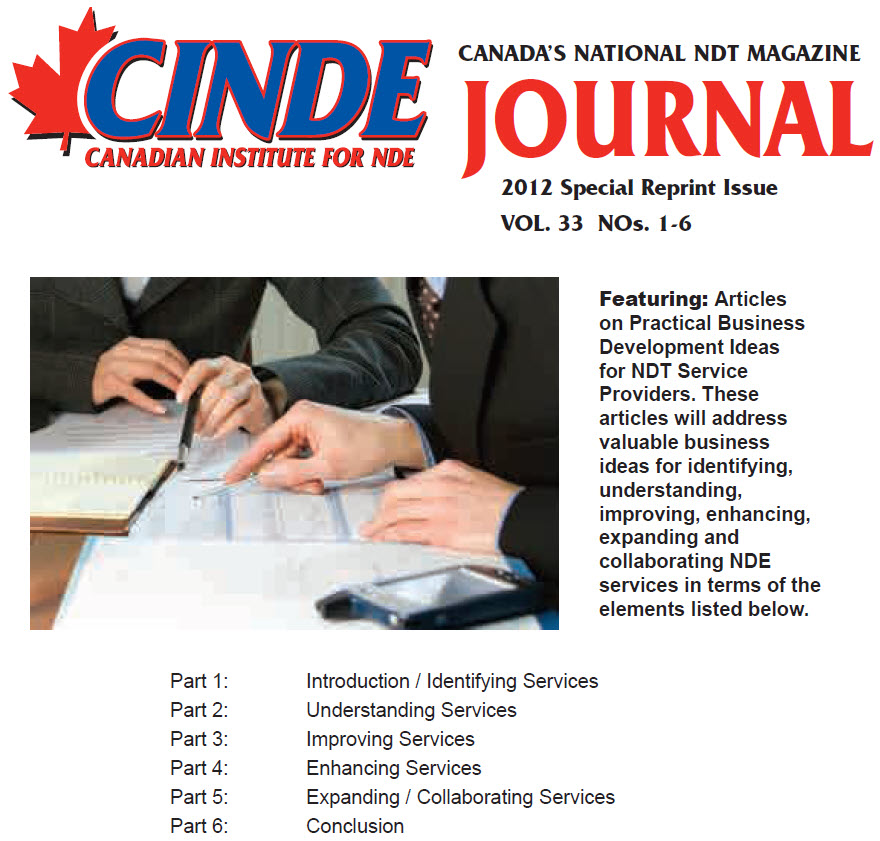Practical Business Development Ideas for NDE Service Providers – Part 2 of 6
Note: This article is the second in a series of six that appeared in the
Canadian Institute for NDE (CINDE) Journal throughout 2012. These articles address valuable business ideas for identifying, understanding, improving, enhancing, expanding, and collaborating NDE services in terms of the elements listed below.

- Introduction / Identifying Services
- Understanding Services
- Improving Services
- Enhancing Services
- Expanding / Collaborating Services
- Conclusion
Related: Effective Supplier Quality Surveillance (SQS).
The Second Element – Understanding Services
Service needs vary significantly depending upon the scope and purpose of the work, for whom the service is to be provided, and many other factors. NDE is a small but important part of projects or jobs that have many other details and technical complexities. For example, NDE may be required for QA/QC, certification, contract, or maintenance purposes that are not always well-defined. As a result, client planning or scheduling may not be as well thought out in advance as it could or should be.
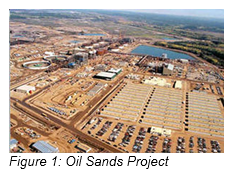
This is especially the case when NDE requirements become fully understood, or are identified and added on to the critical path later in a project. Clients may therefore call urgently at the last minute to request a service, possibly with an unclear picture of what is required or without fully understanding the details of how their wants and needs could or should be met.
Therefore it is imperative to have an open dialogue with a client early in a project to understand and validate their specific needs before scheduling and dispatching any service. For example, an “inspector” could be requested without knowing that the technician dispatched needs to be able to perform a specific magnetic particle testing (MT) technique. The MT techniques include dry, contrast and wet fluorescent (WFMT).
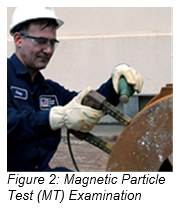
It is also possible that the client could use the same person to perform API or CWB certified visual examinations at the same time. There is nothing worse than someone arriving on a job site who is unprepared or cannot complete all of the work. Establishing the details in advance saves everyone time and money.
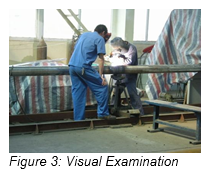
Better yet, before any project kick-off or even before a contract award, well before any services are required, discuss NDE needs with your clients and educate them about your services, to get their feedback about any other wants or needs.
These items or opportunities may be discussed:
- the benefits and limitations of various NDE methods
- the services available and most suited to their needs
- enhancements or other service alternatives that may be provided
- regulatory requirements (e.g., lifting or pressure equipment certification)
- regulations and good practice (e.g., code requirements vs. specifications)
- how technology can provide more effective and efficient services, with fewer resources at a lower overall cost (e.g., for NDE techniques and reporting or data management)
You may also more continuously connect to your client’s wants and needs by:
- having a website that provides good information (such as www.cinde.ca)
- providing presentations at technical meetings (such as the NDT in Canada conference and CINDE chapter meetings)
- writing industry or trade journal articles
- networking to identify business contacts and opportunities
- initiating face to face meetings instead of just making phone calls or emailing
- providing demonstrations with equipment, material, and report examples at trade shows
Successfully connecting services to your clients’ wants and needs means that each of you must have your goals or objectives fulfilled. It also means that the service opportunities must be fully understood and identified. Your services may also be modified or developed to meet different requirements and serve new markets.
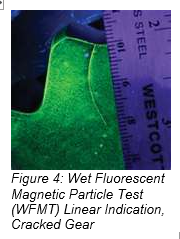
In the article “Environmental Sweet Spot – What do manufacturers, registrars, and consumers all have in common?” on the Quality Digest website, Ryan E. Day relates to Theodore Levitt’s famous quote, “People don’t want a quarter-inch drill; they want a quarter-inch hole”.[1] He says that examining each other’s motives will allow you to propose the most efficient way for each group to fulfill its individual goals, by ensuring the goals of the other group are fulfilled. By finding and defining the common ground, you can easily envision helping each other to reach your individual goals.
Theodore Levitt’s famous quote is also discussed in the Harvard Business Review article “Marketing Malpractice: The Cause and the Cure”[2] by Clayton M. Christensen, Scott Cook and Taddy Hall. The article states that when people need to get a job done, they can hire a product or service to do it for them. The task is to understand what jobs periodically arise (i.e., needs and wants) for which they might hire your company. New markets are created when an innovative company designs a service and then positions its brand on a job for which no optimal or competitive service yet exists. This is great news for smart companies that are hungry for growth. The article includes a one-page preview that quickly summarizes the key ideas and provides an overview of how the concepts work in practice, along with suggestions for further reading.
Diana Rankin said that “instead of thinking about where you are, think about where you want to be. It takes twenty years of hard work to become an overnight success.” [3] Great success does take time, even years, but success can also be achieved every day, with every client and on every job.
Note
This article was originally published in the Canadian Institute for NDE (CINDE) Journal 2012 Vol. 33 No. 2 and in the CINDE Journal 2012 Special Reprint Issue Vol. 33 Nos. 1 – 6. http://www.cinde.ca/journal/
About the Author
Roy O. Christensen is a Welding Engineering Technologist who has over 35 years’ experience with O&G, pipeline, and other projects. He has authored countless instructions, manuals, plans, proposals, reports, specifications, and other documents that continue to drive success for many projects. He is the founder of the KT Project that saves organizations significant money and time, by providing key resources to leverage expert knowledge transfer for successful project execution.
Contact
- Roy O. Christensen
- [email protected]
- +1 403.703.2686
Figures
- Oil Sands Project http://www.hydrocarbons-technology.com/projects/athabasca/images/image1.jpg
- Magnetic Particle Test (MT) Examination http://www.teaminc.com/team_nde_ndt_inspection/images/Magnetic_Particle_IMG_1419.png
- Visual Examination http://www.equipment-inspection.com/Sample%20Inspection/DSCN4819.jpg
- Wet Fluorescent Magnetic Particle Test (WFMT) Linear Indication, Cracked Gear http://www.ndt-training.org/images/mt_uvcrack.jpg
References
- Day, R. E., “Environmental Sweet Spot – What do manufacturers, registrars, and consumers all have in common?”, The Quality Digest website, 2011 http://www.qualitydigest.com/inside/quality-insider-column/environmental-sweet-spot.html
- Christensen, C. M., Cook, S., and Hall, T.. “Marketing Malpractice: The Cause and the Cure”, Harvard Business Review, 2005 http://hbr.org/product/marketing-malpractice-the-cause-and-the-cure/an/R0512D-PDF-ENG
- Rankin, D. Visionary Leadership, The Diana Rankin website http://www.dianarankin.com/Leadership.htm

